| |
|
Austerity, What Austerity? Europe Desperately Needs "Genuine
Austerity" | Print Version |
|
by Chris Leithner* |
Le Québécois Libre, December
15, 2013, No 317
Link:
http://www.quebecoislibre.org/13/131215-6.html
Echoing John Maynard Keynes, today's Keynesians insist that times of
bust are the right time for the government to indulge in extravagance―and the wrong time to return to sobriety. Indeed, Paul Krugman and his
followers go well beyond Keynes: any time is the right time for
profligacy and the wrong time for frugality (see also Paul Krugman,
Keynes Was Right,
The New York Times, 29 December 2011). Krugman and others also
allege that, particularly in Europe, the bailouts and other so-called
stimulus which panic-stricken policymakers “injected” into the structure
of production in 2007-2008 has subsequently been replaced by
“austerity,” and that this austerity has scuttled recovery.
The exemplar of austerity-as-poor-policy, they say, is Greece. That
country, pressured by the EU in general and Germany in particular,
decreased its budget deficit from 10.4% of GDP in 2010 to 9.6% in 2011;
other countries, such as Iceland, Italy, Ireland, Portugal, France and
Spain, also decreased their deficits relative to GDP from 2010 to 2012.
As a consequence of this austerity, Keynesians insist, economic
conditions and prospects have worsened.
He’s no fan of Keynesians, yet Paul Roderick Gregory (“Austerity”
To Blame? But Where’s the Austerity?
Forbes, 26 May 2013) accurately summarises their position:
Die-hard Keynesians bemoan [the fact] that, with a few exceptions, the
world’s economies are drowning in the quicksand of austerity. They
preach we need more government spending and stimulus, not less. Northern
Europe should bail out its less-fortunate neighbours to the South so
they can pay their teachers, public employees and continue generous
transfers to the poor and unemployed. If not, Europe’s South will remain
mired in recession. In America, Keynesians entreat the skinflint
Republicans to loosen the purse strings so we can escape sub-par growth.
They advise Japan to spend itself out of permanent stagnation and
welcome recent steps in this direction.
The stimulationists complain that they have been overwhelmed by the
defeatist austerity crowd, [led] by the un-neighbourly Germans and the
obstructionist Republicans. If only Germany would shift its economy into
high gear while transferring its tax revenues to ailing Southern Europe,
and the rascally Republicans drop the sequester cuts, we would be
sailing along to a healthy worldwide recovery. We don’t need spending
restraint. Instead, we need stimulus, stimulus, and more stimulus to
revive economic growth. We’ll deal with the growing deficits later, the
stimulation crowd tells us, but we must first get our economies growing
again.
The official Keynesian story is that the PIIGS of Europe (Portugal,
Italy, Ireland, Greece and Spain) have been devastated by cutbacks in
public spending. Austerity has made things worse rather than better―clear proof that Keynesian stimulus is the answer. Keynesians claim the
lack of stimulus (of course paid for by someone else) has spawned costly
recessions which threaten to spread. In other words, watch out Germany
and Scandinavia: If you don’t pony up, you’ll be next.
Keynesians see financial crises and economic busts as largely
unpredictable events that governments must prevent at all cost―or,
once they occur, move heaven and earth to alleviate. Adherents to the
Austrian School of economics, on the other hand, explain crises and
busts as the inevitable result of the unsustainable (because it is
artificial) boom provoked by government intervention in general and
central and fractional-reserve banks’ excessive expansion of credit in
particular. Bankers grant the worst loans during the superficially best
times. For Austrians, the boom isn’t a blessing; it’s a curse. Moreover,
recession isn’t a curse: it’s a cure. The bigger is the preceding
artificial boom, the more severe will be the consequent genuine bust.
The recession is the hang-over that follows the blinder; it’s the
cold-turkey that’s necessary in order to kick the addiction to
artificial credit (see in particular Murray Rothbard,
Economic Depressions: Their Cause and Cure).(1)
Like the big bushfire that eliminates the underbrush that the government
forbade landowners to use small fires to remove, the recession is an
inevitable and necessary phase of the business cycle. The bust rids the
economy of the detritus, distortions and mal-investments that
accumulated during the boom. Resources that have been put to
unproductive uses (not least by governments’ perverse incentives,
regulations, decrees, etc.) must either be shifted to sectors where
genuine demand exists―or be liquidated. Clearly, this clean-up and
reorganisation can’t occur overnight; accordingly, some resources must
remain idle until entrepreneurs can find a sensible way to deploy them.
This means that unemployment will temporarily rise, that plant and
equipment will lie partly or fully idle until it can be retooled or
scrapped, and that financial resources will be used to repay debt and
“parked” in short-term assets instead of invested in long-term projects.
To Austrians, then, recession, unemployment and the like aren’t
consequences of austerity; they’re results of the stimulus that kindled
the artificial boom.
Accordingly, governments mustn’t try to retard, delay or prevent this
process of retrenchment, reallocation and recuperation. During the
recession caused by stimulus, in other words, they should avoid further
“stimulus” like the plague. Keynesian “pump-priming,” “automatic
stabilisers,” bailouts and so on vainly sustain the artificial boom,
corrupt the necessary bust and thereby delay and weaken any genuine
recovery. Stimulus is akin to giving a drunk another bottle of whiskey
and an addict another “hit” of heroin. It doesn’t just delay recovery;
in sufficiently large doses it will kill the patient. Stimulus also
creates a climate of uncertainty (Robert Higgs calls it “regime
uncertainty”)
which deters private investment. In short, Keynesians and Austrians
recommend diametrically opposite policies to combat financial and
economic crisis. Keynesians demand that governments redouble their
spending and intervention; Austrians recommend that they slash their
expenditures, taxes, legislation and regulation.
What, exactly, is austerity?
Given these diametrically opposite diagnoses and prescriptions, how
should we view the current situations in Europe? Has austerity prolonged
the crisis, as Keynesians believe? Or, as Austrians maintain, is austerity a necessary condition of recovery?
In order to answer these questions, we must define this key term.
“Austerity measures,” says
The Financial Times Lexicon,
“refer to official actions taken by the government, during a period of
adverse economic conditions, to reduce its budget deficit using a
combination of spending cuts or tax rises.” It adds: “various austerity
measures have been announced since the global recession in 2008 and the
Eurozone crisis in 2009.”(2)
Given the FT’s conception, a sufficient condition of austerity is the
joint occurrence of four things (the first and last of which are
necessary conditions). Specifically, austerity is (a) a decrease of the
government’s budget deficit which has been caused by either (b) a
decrease of government spending or (c) an increase of tax revenues (or
both b and c) and which (d) occurs during a period when GDP is stagnant
or falling. Most descriptions of and disputes about austerity follow the
FT’s conception. They have focussed upon two macroeconomic indicators,
both expressed as a percentage of GDP: (1) the government’s budget
deficit and (2) debt as a percentage of GDP. The lower the deficit (that
is, the higher the surplus) and the more the debt shrinks, the more
austere is the policy.
More generally, it seems to me that austerity means not just that the
government temper but that it abandon its profligacy. It doesn’t merely
tug the fiscal belt slightly: it yanks as hard as necessary in order to
live within its means. Austerity means that when a government
figuratively stands in the doctor’s surgery and receives an unvarnished
diagnosis―namely that it’s bloated and unfit―it doesn’t choose the
slack option. It doesn’t borrow in order to buy even bigger trousers:
instead, it convincingly resolves immediately to fit into smaller
clothes by adopting a strict diet and commencing rigorous training. At a
minimum, austerity worthy of the name means that the government
eliminates its budget’s deficit; more ambitiously, it means that both
its spending and its revenues fall significantly, even drastically, that
its expenditures quickly become smaller than its shrunken revenues, and
that it uses the resultant budget surplus to repay a significant portion
of its debt.
Are governments and households, in at least one key respect, comparable? “What is prudence in the
conduct of every private family,” wrote Adam Smith in
The Wealth of Nations
(1776), “can scarce be folly in that of a great Kingdom.” Here, too,
Keynesians and Austrians differ diametrically. Austrians reason from two
premises. Firstly, households and businesses cannot live indefinitely
beyond their means; secondly, the government confiscates either from
households or businesses. From these premises it follows that
governments, like the households and businesses that finance them,
cannot live indefinitely beyond their means. And because nobody can live
indefinitely beyond his means, everybody (including the government) must
ultimately live within his means. If he doesn’t, then as a matter of
elementary logic he must live within somebody else’s means―whether
that somebody else is aware of it or not, and regardless of whether that
somebody likes it no not. From the point of view of the Austrian School
of economics, then, austerity is moral and rational, and profligacy is
immoral and irrational.
Keynesians utterly reject these premises and reasoning, as well as the
morality that underlies it. In the words of James K. Galbraith (In
Defense of Deficits, The Nation,
4 March 2010:
It may seem
like homely wisdom to say that “just like the family, the government
can’t live beyond its means.” But it’s not. In these matters the public
and private sectors differ on a very basic point. Your family needs
income in order to pay its debts. Your government does not … With
government, the risk of non-payment does not exist. Government spends
money (and pays interest) simply by typing numbers into a computer.
Unlike private debtors, government does not need to have cash on hand …
No government can ever be forced to default on debts in a currency it
controls. Public defaults happen only when governments don’t control the
currency in which they owe debts―as Argentina owed dollars or as
Greece now (it hasn’t defaulted yet) owes Euros. But for true
sovereigns, bankruptcy is an irrelevant concept. When Obama says, even
offhand, that the United States is “out of money,” he’s talking nonsense―dangerous nonsense. One wonders if he believes it. Nor is public debt
a burden on future generations. It does not have to be repaid, and in
practice it will never be repaid.
A question to Galbraith: if you’re right, then why does the government
bother to levy taxes? Why doesn’t it simply borrow whatever it pleases,
without limit, every year?
Keeping the broad conception of austerity (i.e., “living roughly within
one’s means”) and its morality in mind, it’s worth mentioning that, for
members of the EU, austerity or some rough facsimile thereof is a key
promise and treaty obligation. It’s also important to repeat:
descriptions of and disputes about austerity have focussed upon two
macroeconomic indicators, both expressed as a percentage of GDP: (1) the
government’s budget deficit and (2) its debt as a percentage of GDP. The
Maastricht Treaty of 1992
stipulates that the budget deficit of a country joining the EU must be
no greater than 3% of its GDP, and that its level of debt must be no
higher than 60% of GDP. These are also “goalposts” for member countries;
fortunately for them and unfortunately for people who believe
politicians, however, few take these “Maastricht criteria” seriously.
Figure 1 shows that the budget deficit of the average EU member state is
presently (mid-2013) 4.0% of GDP, and Figure 2 shows the government debt
of the average member of the EU is 72.5% of GDP. It’s rather comical: by
these criteria the average EU country doesn’t qualify (according to
Maastricht criteria) for admission to the EU! Indeed, all major EU
nations except Germany fail the budget deficit test: Britain, France,
Italy and Spain all do. And all of the EU major member states, including
Germany, fail the debt-to-GDP criterion. (www.tradingeconomics.com
is the source of these and all subsequent presentations of data from EU
countries.)
Figure 1: Ratio of Government Budget Surplus or Deficit to GDP (%), EU
Members, 2013
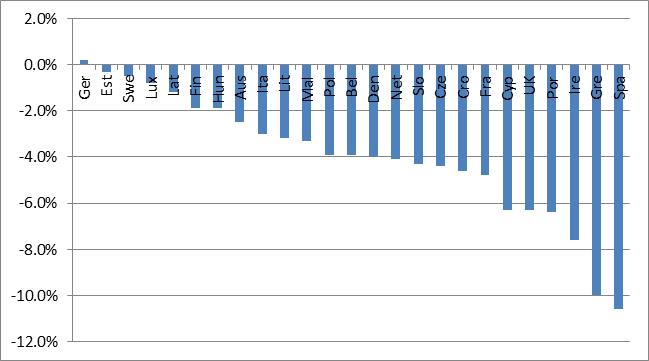
Figure 2: Ratio of Government Debt to GDP (%), EU Members, 2013
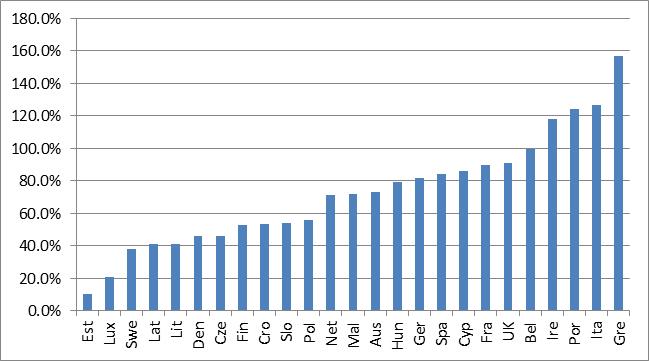
By these two criteria, in other words―which are not mine but are
rather part of the EU’s “architecture”―there is no “austerity” in
Europe.
Virtually without exception, member states of the EU aren’t honouring
their obligations under the Maastricht Treaty. Because they’re not
living within their means, according to criteria agreed by treaty more
than 20 years ago, they’re not practicing austerity.
Three Varieties of Austerity
Recall from The Financial Times Lexicon that measures of
austerity reduce the government’s budget deficit. If the deficit is
rising, then by definition there’s no austerity. How to trim a deficit?
The government must cut its spending, increase its revenue or adopt some
combination of these two things. Generally speaking and regardless of
their rhetoric, politicians of all partisan stripes love to increase
expenditure and reduce taxes (which rewards their mascots), and they
hate to reduce expenditure and to increase taxation (which punishes
their followers). Two varieties of austerity, one legitimate and the
other bogus, thus follow:
Genuine Austerity
Politicians’ and bureaucrats’ least favoured way to reduce the deficit
is to implement genuine austerity, i.e., to cut spending drastically
(both in absolute terms and as a percentage of GDP) and to slash taxes
considerably. If they do these things (such that the government’s
revenues decrease and its expenditures fall even more, thereby turning
the budget suddenly and sharply into surplus), and if they use this
surplus to trim the debt, they shrink the size of the state; and if they
do so whilst GDP is stagnant or falling, then they’re implementing
“genuine” austerity.
Not Genuine But Not Completely Fraudulent Austerity
The intermediate (but still relatively unappealing, if you’re a
politician or bureaucrat) way to reduce the government’s budget deficit
is to (1) halt the growth of spending for a short period of time and (2)
greatly increase its revenues (by either increasing the rate of existing
taxes, or introducing new taxes, or both) for a long time. These two
measures, plus (3) the hope that the growth of GDP resumes quickly
enough to remove the pressure to take further unpalatable decisions, may
reduce the deficit somewhat as a percentage of GDP, but probably won’t
decrease it in absolute terms. And it’ll do nothing to reduce debt;
indeed, debt (in absolute terms, if not as a percentage of GDP) may
rise; for this reason, the state continues inexorably to grow. This
approach, broadly speaking, describes short periods in the 1980s in
Britain and the U.S.
Faux austerity
“Faux” (false) austerity entails higher government expenditure, albeit
perhaps at a slower pace than during the era before “austerity”
commenced. A deceleration of the rate of increase of government
expenditure, in other words, underpins
faux austerity (in mathematical terms, the second derivative becomes
negative, but the first derivative remains positive). So too do either
increases of existing taxes or the introduction of new taxes, which
increase the government’s revenues more quickly than its expenditure,
and thereby reduce its deficit. Unlike genuine austerity, which shrinks
the state’s income statement and balance sheet, faux austerity, which is
typically financed by borrowing (often at an accelerating pace) produces
an ever-bigger state. This, or something roughly like it, occurred in
Britain during most of the Thatcher years, most of the Reagan years in
the U.S. and during the early Howard years in Australia. As we’ll see
shortly, it also characterises the EU and U.S. since 2007.
In principle, then, “austerity” of one or another of these varieties can
cover many different and otherwise incommensurate situations.
Specifically, it can apply just as well to (a) the common situation
where the size of the state increases rapidly, (b) the ubiquitous
situation where the size of the state rises at a relatively steady pace
and (c) the very rare situations where the state suddenly shrinks
meaningfully.
A Textbook Example of Genuine Austerity That Appears in No Mainstream
Text
Have you heard of the Depression of 1920-1921? I thought not. Why not?
Probably because, as I detailed in
The Evil Princes of Martin
Place, it ended so quickly. Why did it end so quickly? The U.S.
Government quickly and resolutely implemented genuine austerity. Figure
3 plots U.S. GNP during two eight-year periods: 1916-1923 and 1928-1935.
To aid comparison of these two intervals, it standardises GNP in the
first year of each at 100. (Historical Statistics of the United
States is the source of this and subsequent figures that use
American data before 1970.)
Figure 3: U.S. GNP (Year 1=100), 1916-1923 and 1928-1935
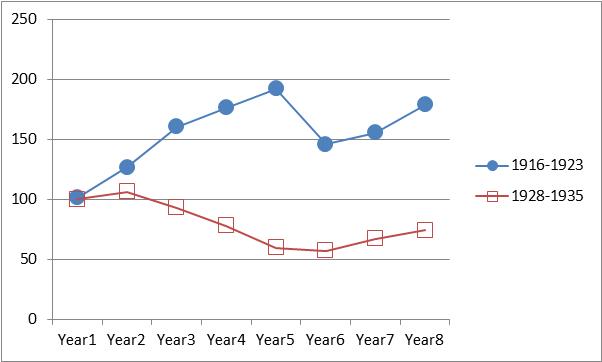
Figure 3 shows that the decrease of GNP between 1920 and 1921 (a
whopping 24%) was far greater than in any single year of the Great
Depression. From the peak in 1929 to the trough in 1933, GNP in the U.S.
fell by a cumulatively greater amount (46%); but during the first three
years of the Great Depression, GNP fell only slightly more (26%) than it
did in the single year from 1920 to 1921. Not only was 1920-1921 (to use
the phrase of the FT Lexicon) a “period of adverse economic conditions”:
it was, economically speaking, America’s single worst interval of the 20th
century. Notice, however, that after 1921 GNP rose sharply: from 1921 to
1922 it rose 6.5%; from 1922 to 1923 it soared almost 15%; and
thereafter (not shown) it continued to rise strongly. The Depression
of 1920-1921 was the severest in America’s 20th century
history; it was also the shortest in America’s 20th century
history. That latter attribute is perhaps why few Americans remember
it.
Figure 4: Expenditure and Revenue, U.S. Government ($m), 1916-1923
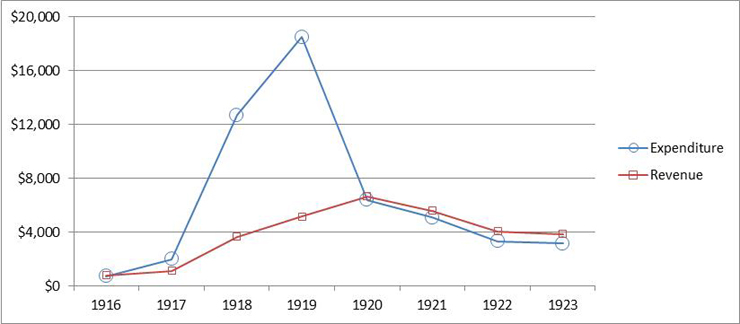
How did the U.S. Government respond to the Depression of 1920-1921? By
drastically slashing both expenditures and revenues, in absolute terms
and also as a percentage of GNP; in other words, it did the diametric
opposite of what Keynes recommended in 1937 and what Krugman and others
demand today. Indeed, slashing its taxing and spending, which the
First World War had bloated massively, likely triggered (as opposed to
caused) the Depression. (The preceding “stimulus,” in the form of the
massive growth of government during the First World War, and the
aggressive interventionism of the Federal Reserve, which was formed in
1913, caused the Depression.) Figure 4 shows that the U.S. Government’s
expenditure skyrocketed from $713 million in 1916 to $18.5 billion in
1919; spending then plummeted to $6.4 billion in 1920, $5.1 billion in
1921, $3.7 billion in 1922 and $3.5 billion in 1923. That’s no
typographical error: from the crest of the wave of spending in 1919 to
its trough in 1923, the U.S. Government’s expenditure plunged 81%.
Revenue followed a similar but less extreme path: it rose from $761
million in 1916 to $6.6 billion in 1920, and then fell steadily to $3.9
billion in 1923. Also note that from 1920 to 1921, which we saw in
Figure 3 was the single worst year in the 20th century, the
U.S. Government’s revenue fell 20% (from $6.4 billion in 1920 to $5.6
billion in 1921); from 1920 to 1923, revenue fell 42%.
Figure 5 expresses the U.S. Government’s surplus/deficit in each of
these years as a percentage of GNP during the relevant year. In 1916,
the government roughly balanced its budget; in 1917, as America entered
the First World War, it ran a huge deficit (ca. 12% of GNP); and in 1919
(the war ended in November 1918, but the spigot took a bit of time to
seal), its deficit was even bigger (ca. 16% of GNP). Notice, however,
that within a year the government’s budget returned to surplus (ca. 0.5%
of GNP in 1920), and that for the next three years it remained in
surplus. Notice, too, that during the Depression of 1920-1921 the
U.S. Government’s budget surplus increased. During the worst year of the
20th century, in other words, the government’s spending
plunged even more rapidly than its revenue. This, I think, is why
Keynesians utterly ignore the Depression of 1920-1921 and attempt to
rationalise it when reprobate students bring it to their attention:
Keynesians simply cannot explain how the drastic shrinkage of the
government’s taxing and spending immediately preceded the strongest
recovery of the 20th century. What they cannot explain, they
ignore or deny.
Figure 5: the U.S. Government’s Budget Surplus/Deficit, Percentage of
GNP, 1916-1923
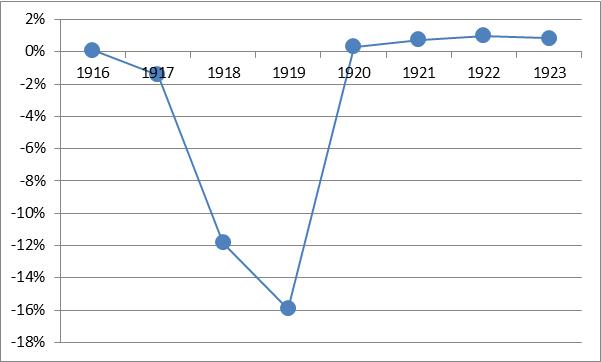
What did the U.S. Government do with the surpluses it generated after
1920? It used them to repay some of the debt which had exploded
during the First World War. Figure 6 expresses the U.S. Govern-ment’s
debt during a given year as a percentage of GNP during that year.
Admittedly, debt rose between 1920 and 1921. This, presumably, was the
final installment of a longer series: the First World War caused
America’s debt to balloon from ca. 3% of GNP in 1916 to 35% in 1921. By
1923, however, debt was closer to 25% of GNP―a far cry from the level
in 1916, to be sure; equally certainly, it was significantly less in
1923 than it was in 1921.
Figure 6: Ratio of Debt to GNP, U.S. 1916-1923
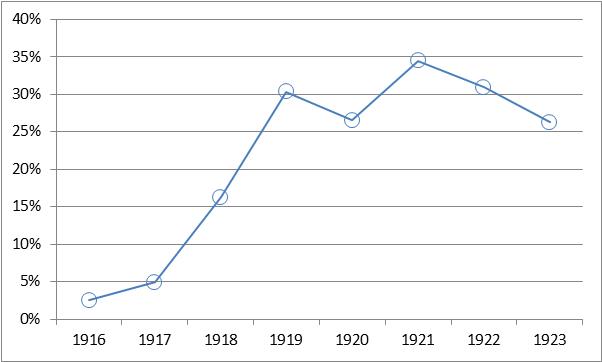
Let’s recapitulate. The Depression of 1920-1921 was the severest in
modern American history. Yet the recovery in 1921-1923 was the most
robust in that country’s modern history. How do we explain these facts?
The Austrian School tells us that the genuine austerity of the U.S.
Government, which quickly and thoroughly removed many of the
distortions, malinvestments, etc., introduced during the war, had much
to do with it. The implication is vital: genuine austerity doesn’t cause
misery, it resolves it. Genuine austerity purges the rottenness of the
false boom and thereby sets the stage for genuine recovery. Faux
austerity and Keynesian-style stimulus, on the other hand, cause misery
and indefinitely postpone recovery.
The EU and U.S. since 2005: No genuine austerity but plenty of faux
austerity
Presently, the critics of austerity take it for granted that governments
in the EU (particularly the PIIGS) have drastically their expenditure.
It’s also an article of faith among these critics that this alleged
austerity (which, they maintain, has also occurred in the U.S.) has
shrunk if not eviscerated the state. Do the facts support these
assumptions? Figure 7 sorts EU member states into three
slightly-overlapping categories: (a) major members (Britain, France,
Germany, Italy and Spain), PIIGS (Portugal, Ireland, Italy, Greece and
Spain) and non-major members (i.e., all others), and expresses overall
government expenditure in each category relative to 2005 (=100).
Figure 7: Government Expenditure, EU and U.S., 2005-2013 (2005=100)
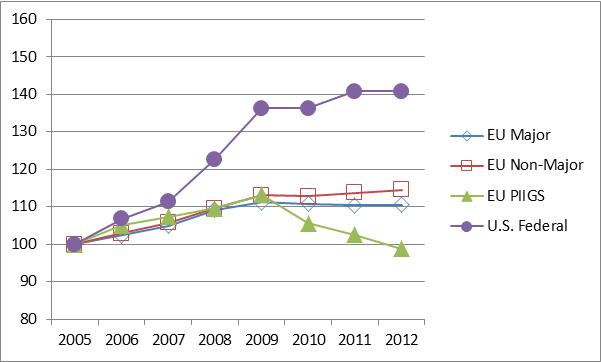
In the U.S., expenditure increase by 40%―that is, at a compound rate
of 4.9% per year―between 2005 and 2012. Government expenditure also
increased, albeit more slowly, across the EU from 2005 to 2009. It
increased by 12-14% and at a compound rate of 2.8-3.3% per year. In
2009-2012, on the other hand, spending changed little in major member
states, increased slightly (by a total of ca. 3% and at a compound rate
of 0.6% per year) in non-major states, and fell (by a total of 12% and
at a compound rate of 4.4%) in the PIIGS.
Figure 8 plots total government expenditure (2005=100) in Portugal,
Ireland, Italy, Greece and Spain between 2005 and 2012. It shows that
expenditure rose
in 2005-2008. On average in these countries, it rose 10% (i.e., at a
compound rate of 3.2% per year) during this interval. It rose 28% in
Spain (compound rate of 8.9% per year), between 5-10% in Portugal,
Ireland and Greece (compound rate of ca. 2.3-2.5% per year) and changed
little in Italy. Conversely, in 2008-2012 expenditure fell. It fell 11%
in Portugal (at a compound rate of 3.9% per year), 13% in Ireland (4.4%
per year) and 17% in Greece (6.3% per year). Does this more recent
shrinkage of government expenditure confirm that these three PIIGS, at
least, have endured austerity?
Figure 8: Government Expenditure, PIIGS and U.S., 2005-2012 (2005=100)
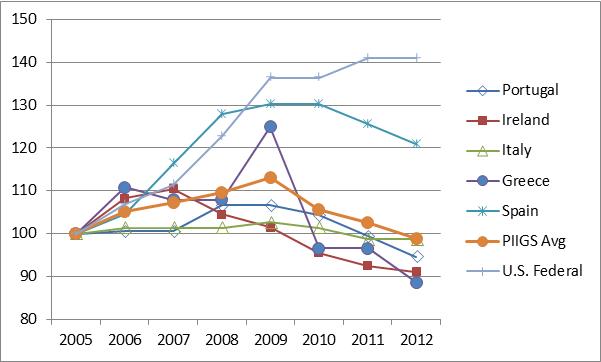
Not really. Figure 9 plots average annual budget deficits (expressed as
a percentage of each country’s GDP) in the U.S. these three categories
of EU member states.
Recall the Financial Times Lexicon: “…
various austerity measures have been announced since the global
recession in 2008 and the Eurozone crisis in 2009” (italics added).
Clearly, however, by and large they haven’t been implemented. A
decrease of the government’s budget deficit is a necessary condition of
austerity. Without exception, however, budget deficits across the EU
have been considerably greater since 2009 than they were before then.
But nobody denounced these deficits as “austere” then; so how can
Keynesians do so now?
Figure 9: Budget Deficits as a Percentage of GDP, EU and U.S., 2005-2012
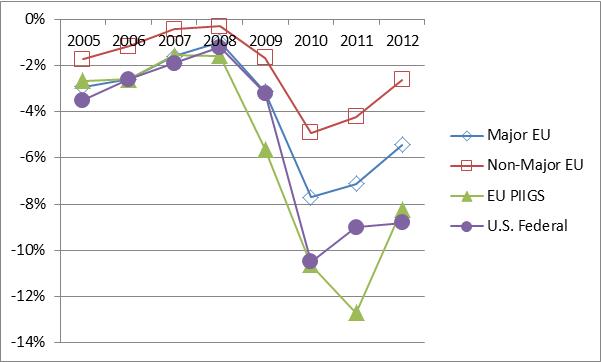
It’s true that in 2012 deficits were smaller than they were in 2010 and
2011. The average deficit in major EU countries was smaller in 2012
(-5.4% of GDP) than it was in 2010 (-7.7%); the average deficit in
non-major countries was also less in 2012 (-3.6%) than in 2010 (-6.0%);
finally, the deficit in the average deficit in PIIGS nation was smaller
in 2012 (-8%) than in 2010 (-11%) and 2011 (-13%).
The trouble, of course, is that “stimulus” rules: across the EU, as well
as in the U.S. budget deficits remain very large―smaller than at their
nadir, but nonetheless far greater than before 2009. Whereas
Keynesians decry “austerity” in 2012 vis-à-vis 2010, Austrians see
“stimulus” after 2009 vis-à-vis the boom until 2007.
Figure 10: Budget Deficits as a Percentage of GDP, PIIGS Nations,
2005-2012
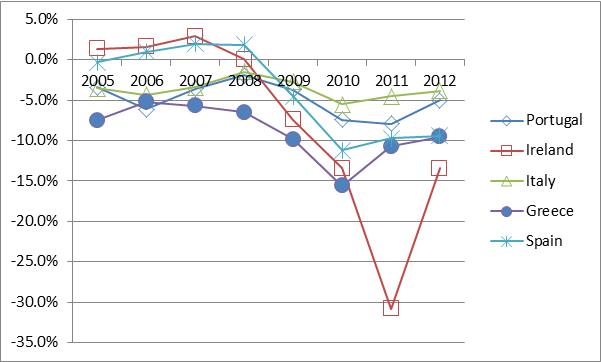
Not only do Figures 7-11 show no compelling evidence of genuine
austerity; they demonstrate that the evidence of faux austerity is
strongest in the U.S. and PIIGS nations. Although government expenditure
in the PIIGS nations has fallen in 2009-2012 (Figure 7), it remains far
too high relative to revenues. Accordingly, as their budget deficits
have ballooned (Figure 8), governments have borrowed increasingly
heavily, and the PIIGS and U.S. Government have borrowed most heavily of
all (Figure 10 and 11). As a result, since 2009 the average PIIGS government’s
debt as a percentage of GDP has risen from ca. 75% to almost 120%, which
is only slightly greater than America’s. That’s evidence of profligacy
and an even more bloated state―not of genuine austerity and a leaner
and fitter state.
Figure 11: Government Debt to GDP (%), EU and U.S., 2005-2012
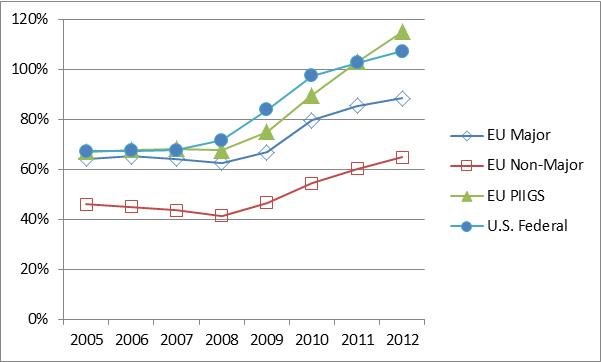
Why the “Recovery,” Particularly Among the PIIGS, Has Been So Anaemic
Keynesians in general and Paul Krugman in particular insist that the
recovery in the EU and U.S. has been so anaemic because the stimulus and
bailouts, etc., in 2007-2009 were too feeble, and because “austerity”
(as we’ve seen, faux prosperity is a more accurate description) replaced
Keynesian stimulus. They’re demonstrably and diametrically wrong:
recovery has been so feeble not because austerity has been much too
severe; it’s been so weak because “austerity” has been far too timid.
Figure 12 combines data from the U.S. in 1916-1923 (Figure 5) and from
the EU in 2005-2012 (Figure 9). It shows that the faux austerity that
Krugman and others decry simply bears no comparison to the genuine
austerity that the U.S. Government implemented in the early 1920s. In
effect, the welfare-warfare state weights almost as heavily today upon
the EU and U.S. today as the First World War did upon the U.S.
Government. The inference is clear: whereas the Americans’ genuine
austerity quickly and thoroughly put the government’s house into some
semblance of order, the PIIGS finances remain in disarray. The
Americans’ genuine austerity created the conditions of genuine recovery;
in sharp contrast, the PIIGS’ faux austerity has begotten a faux
recovery.
Figure 12: Budget Deficits (% of GNP/GDP), 1916-1923 and 2005-2012
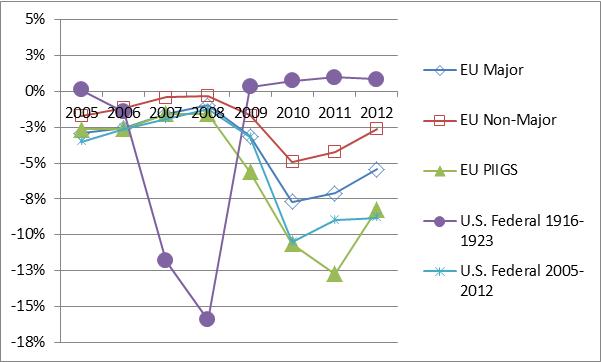
Figure 13 combines data from the U.S. in 1916-1923 (Figure 6) and from
the EU in 2005-2012 (Figure 10). In the early 1920s, the U.S. Government
implemented genuine austerity; as a result, its debt (expressed as a
percentage of GNP) fell significantly. By today’s lax standards, in the
1920s the U.S. Government was astonishingly trim; accordingly, it didn’t
block the road to economic recovery. In sharp contrast, today in the EU
and U.S. debt continues to gallop upwards; as a result, the bloated
government has “crowded out” private recovery.
Figure 13:
Ratio of Debt to GNP/GDP, 1916-1923 and 2005-2012
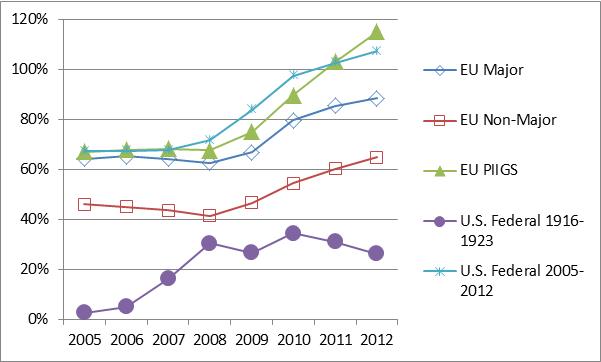
Three Conclusions
Never mind Paul Krugman: at no time since 2005 have governments in the
EU or U.S. implemented genuine austerity. Instead, they’ve recently
championed faux austerity. Accordingly, their “recoveries” from the
economic and financial crisis are feeble and artificial; moreover, like
Australia they remain vulnerable to renewed economic and financial
crisis.
1. Today, Austerity Is Everywhere Except in the Statistics
A researcher at the German Institute for Economic Research, Georg Erber,
The Austerity Paradox: I See Austerity
Everywhere, But Not in the Statistics,
28 February 2013), examines in much greater detail than I have the EU’s
official statistics.
Erber writes:
… taking a close look at the actual statistics available from Eurostat
on the PIIGS-countries plus Cyprus, one finds little empirical evidence
that the governments there [or in the EU more generally] have de facto
reduced their total public expenditures. This is in stark contrast to
the current austerity debate, which seemingly implicitly assumes that
austerity has occurred over the past couple of years since the global
Great Economic Crisis broke out in 2008.
The PIIGS remind me of the patient whose doctor orders him to lose
weight by eating less. The patient responds by doubling his calorie
intake. He later cuts back by ten percent and wonders why he is not
losing weight. The PIIGS went on a spending binge from which they do not
want to retreat. They then blame their problems on austerity and the
lack of charity of others.
So much for the scourge of austerity in … Europe. The facts show it
simply does not exist. Instead of “where’s the beef?” we should ask
“where’s the austerity?” Perhaps economist [Paul] Krugman can find it.
But first I would advise him and others like him to consult some facts
before they pontificate.
Adam Creighton agrees. In
Nothing Austere about Europe’s Fiscal Policies
(The Weekend Australian, 11-12 May 2013), he writes:
If thought corrupts language, language can also corrupt thought. A bad
usage can spread by tradition and imitation even among people who should
and do know better. In 1946 George Orwell famously pointed out how
politics degraded and abused the English language for the sake of
political ends. The same is true in economics. The word austerity, used
to describe European and even U.S. fiscal policy, has been a clever ruse
by opponents of measures that may cause any reduction in the size of
government.
No objective, sane person could describe, in a relative or absolute
sense, fiscal policy in Europe or the US as austere, a word stemming
from the Greek meaning harsh or severe. … Government budget deficits in
Europe are still up to twice as large as they were before the GFC―when
no one described them as austere―and are contributing to already vast
public debt burdens. Far from the “savage cuts” of [former Treasurer]
Wayne Swan’s imagination, European governments have reduced only the
rate of growth of public spending. Even in Greece, a country with little
population or economic growth in recent years, spending is still greater
than it was five years ago.
Yet “mindless austerity” has become a favourite phrase of the Treasurer
since [Swan] dumped his promise to restore the budget to surplus this
financial year. … The Treasurer is trying to convince Australians that
cutting public spending would undermine “jobs and growth.” Whatever is
undermining jobs and growth in Europe, it is likelier to be a bizarre
fondness for bad economics than spending cuts.
Creighton quotes Alberto Alesina, a professor of economics at Harvard
University:
[There is] vast evidence showing spending cuts are much less
economically costly than tax increases to restore budgets to surplus …
Lower spending reduces the expectation of higher taxes in the future,
with positive effects on … investors. … Most countries in Europe are
actually raising taxes and not cutting expenses; what happens in
practice is typically quite different from what is announced (see also
Adam Creighton, “Economists Attack Wayne on Austerity/Dons Slam
Treasurer on Austerity Stand,” The Weekend Australian, 11-12 May
2013).
2. Keynes was wrong and Krugman is similarly wrong―and the Austrians
have been correct all along
“The boom, not the slump, is the right time for austerity at the
Treasury,” John Maynard Keynes asserted in 1937. That’s flatly wrong.
The greatest slump in the 20th century history of the U.S.
occurred in 1920-1921. The Depression of 1920-1921 was the shortest in
America’s 20th century history―and the recovery from the
Depression of 1920-1921 was the most robust in America’s modern history―precisely because the U.S. Government followed the opposite―and
correct―path. It demonstrated that the bust is a correct time for
genuine austerity. Krugman, too, is diametrically wrong. The truth is
that any time, boom or bust, is the right time for the state to
adopt frugality and the wrong time to embrace extravagance.
What’s more, we’ve long known that Keynes and Krugman are wrong. (See
the quotes by John Stuart Mill and James Callaghan after the Overview.)
Martin Masse (Is
“Austerity” Responsible for the Crisis in Europe?
Mises Institute, 11 June 2013) adds two final points. Governments in
almost all member nations of the EU are now at least as large, and
probably larger, than in 2007. If (like The Financial Times Lexicon)
we define austerity as measures undertaken which reduce the government’s
budget deficit, then faux austerity has deepened the crisis. And if we
define genuine austerity as policies which reduce the size of
government, then Keynesians―if they are intellectually honest―must
exonerate genuine austerity from all blame. Genuine austerity hasn’t
deepened the crisis because since 2007 it has never been applied.
“Unfortunately,” Masse concludes, “confusion over the meaning of
austerity impedes a better understanding of the situation and precludes
a more relevant debate over the causes of and solution to the crisis.”
He continues:
Keynesians will, of course, regret that even larger increases of
government borrowing and deficit spending hasn’t occurred. These things,
which certainly have marked the state’s finances during the past few
years, have been implemented in order to “stimulate” the economy. But,
from an Austrian perspective, bloated governments and higher taxes help
to explain why, several years after the financial crisis, American and
European economies are still in the doldrums.
3. Genuine austerity doesn’t kill―But faux austerity does cause misery
How to respond to claims such as
Why Austerity Kills: From Greece to U.S., Crippling Economic Policies
Causing Global Health Crisis
(Democracy Now! 21 May 2013)? The Depression of 1920-1921
demonstrates that genuine austerity doesn’t cause misery: it removes it.
Genuine austerity sets the stage for genuine recovery. Faux austerity,
on the other hand, corrupts recovery and thereby causes misery. Not
just for material reasons, then, but also on moral grounds, what the
world desperately needs is drastically smaller government: not just a
much smaller quantity of taxing and spending, but also a vast pruning of
legislation and deregulation of capital and labour. These measures will
encourage savings, investment and entrepreneurship. They―and not more
taxing, spending, legislating and regulating―will thereby set a sound
foundation for a return to prosperity.
Notes
1. Followers of Keynes seldom anticipate recessions, never mind crises,
and so these things always surprise them. Followers of Ludwig von Mises,
Murray Rothbard and Hans-Hermann Hoppe, on the other hand, usually
anticipate downturns, crashes and crises―and are surprised when they (usually)
don't occur. To Keynesians, in other words, the glass isn't just full:
it's overflowing. Austrians, on the other hand, see a crack in a brittle
and mostly-empty vessel. As a result, Keynesians are normally complacent
and Austrians fretful.
2. See also “Austerity Europe: Who Faces the Cuts” (The Guardian, 12 June
2010); Brian Wesbury and Robert Stein (“Government Austerity: The Good,
Bad and Ugly,” Forbes, 27 July 2010); and Paul Krugman (“The Austerity
Agenda,” The New York Times, 31 May 2012).
----------------------------------------------------------------------------------------------------
*This is an adapted and shortened version of a paper presented to the
Mises Seminar Emporium Hotel, Brisbane, Queensland, on November 30,
2013.**Chris Leithner grew up in Canada. He is director of
Leithner & Co. Pty.
Ltd., a private investment company based in Brisbane, Australia. |

